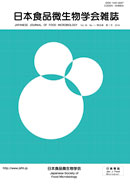
- Issue 4 Pages 173-
- Issue 3 Pages 105-
- Issue 2 Pages 67-
- Issue 1 Pages 1-
- |<
- <
- 1
- >
- >|
-
Naoaki Misawa2018Volume 35Issue 4 Pages 173-178
Published: December 30, 2018
Released on J-STAGE: January 09, 2019
JOURNAL FREE ACCESSDownload PDF (354K)
-
Naomi Takahashi, Yuka Moriya, Yuka Takatsu, Naoko Kaneta, Yumiko Tomim ...2018Volume 35Issue 4 Pages 179-186
Published: December 30, 2018
Released on J-STAGE: January 09, 2019
JOURNAL FREE ACCESSThe automatic ATP measurement system was applied to rapid test for coliforms in milk and yogurt. The methods by bioluminescence assay after selective enrichment culture were evaluated, and following results were obtained. When a bioluminescence assay was applied to detect coliforms after BGLB enrichment, the results were affected by ATP derived from lactic acid bacteria. Conversely, dLST (LST with sodium deoxycholate) or nBGLB (BGLB with nisin) enrichment was able to minimize the influence of lactic acid bacteria. Because preparation of dLST was easier than nBGLB, it was concluded that dLST is the most suitable enrichment broth for use in detecting coliforms in yogurt by bioluminescence assay. The dLST-ATP method with an automatic ATP measurement system after eight hours dLST enrichment was able to detect 1–10 cfu/mL levels of coliforms in milk and 1–10 cfu/0.1 g levels of coliforms in yogurt. Inclusivity of the dLST-ATP method as a presumptive coliforms test is 100.0%, and exclusivity is 90.3%. The results of the comparative study showed that there was a significant correlation between the dLST-ATP method and the BGLB method, and the desoxycholate agar method. The dLST-ATP method takes only about eight hours for presumptive coliforms test, and the method is simple and can be used not only for milk samples but also yogurt samples. Considering these results, the dLST-ATP method should be useful as a rapid test for coliforms in milk and yogurt.
View full abstractDownload PDF (416K)
-
Yoshimasa Sasaki, Yumiko Okada, Masashi Uema, Hiroshi Asakura, Mamoru ...2018Volume 35Issue 4 Pages 187-192
Published: December 30, 2018
Released on J-STAGE: January 09, 2019
JOURNAL FREE ACCESSDownload PDF (323K)
-
Kenta Terauchi, Hirotaka Matsumoto, Tomomi Yamazaki, Toshihiro Kuroita ...2018Volume 35Issue 4 Pages 193-198
Published: December 30, 2018
Released on J-STAGE: January 09, 2019
JOURNAL FREE ACCESSNorovirus causes acute gastroenteritis, and foodborne outbreaks have become a serious concern globally, occurring especially during the winter. The contamination of food by norovirus can often be attributed to infected food handlers. Therefore, the management of food handlers presenting with gastrointestinal symptoms must be handled very carefully. As norovirus infections are often asymptomatic, it is highly recommended that all food handlers be tested for infection to reduce the risk of contaminating food products. The intensive surveillance of food handlers for norovirus necessarily requires a rapid and sensitive system for detecting the norovirus genome in fecal specimens. Until now, a nucleic acid amplification test kit for norovirus genome has been used, based on a one-step real-time PCR using heat-treated fecal specimens as templates (heat-treatment kit). In the present study, we have evaluated a new kit that does not require the fecal specimens to undergo heat-treatment. Our results suggest that this new kit exhibited a detection sensitivity of 105 noroviral genome copies order/g stool, a similar value to that of the heat-treatment kit. Because of the simplified test protocol, the new kit had a shorter turnaround time and a lower risk of cross-contamination than the heat-treatment kit. In view of these advantages, the new kit should be able to provide a more rapid and reliable nucleic acid test for detecting norovirus.
View full abstractDownload PDF (492K)
- |<
- <
- 1
- >
- >|